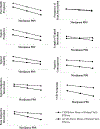Marijuana protective behavioral strategies and marijuana refusal self-efficacy: Independent and interactive effects on marijuana-related outcomes
- PMID: 30869920
- PMCID: PMC6554061
- DOI: 10.1037/adb0000445
Marijuana protective behavioral strategies and marijuana refusal self-efficacy: Independent and interactive effects on marijuana-related outcomes
Abstract
Separately, research has identified use of marijuana protective behavioral strategies and marijuana refusal self-efficacy to be protective factors associated with less marijuana use and associated harms. To date, these factors have not been examined together. Using a large sample of college students recruited from 10 U.S. universities (n = 1,123), we examined the extent to which use of marijuana protective behavioral strategies and marijuana refusal self-efficacy have redundant, independent, or interactive effects on a wide range of marijuana-related outcomes using cross-sectional data. Across 9 marijuana-related outcomes, we found 1 significant buffering interaction (length of typical intoxication), 1 significant synergistic interaction (peak subjective intoxication), and 7 nonsignificant interactions (past month frequency, typical frequency, typical quantity, typical subjective intoxication, frequency of peak intoxication, negative consequences, and cannabis use disorder symptoms). Despite variability across distinct outcomes, on 8 of 9 of these outcomes, we found that individuals who reported high use of marijuana protective behavioral strategies and high levels of marijuana refusal self-efficacy demonstrated the lowest rates of marijuana use/harms. Our findings suggest that both of these factors are promising intervention targets, and future studies should examine distinct intervention strategies to modify use of marijuana protective behavioral strategies and marijuana refusal self-efficacy. (PsycINFO Database Record (c) 2019 APA, all rights reserved).
Figures
References
-
- Bandura A (1977). Self-efficacy: Toward a unifying theory of behavioral change. Psychological Review, 84, 191–215. - PubMed
-
- Bandura A (1986). Social foundations of thought and action: A social cognitive theory. Englewood Cliffs, New Jersey: Prentice-Hall, Inc.
-
- Bandura A (1994). Self-efficacy In Ramachaudran VS (Ed.), Encyclopedia of human behavior (Vol. 4, pp. 71–81). New York: Academic Press.
-
- Bravo AJ, Anthenien AM, Prince MA, Pearson MR, & Marijuana Outcomes Study Team. (2017a). Marijuana protective behavioral strategies as a moderator of the effects of risk/protective factors on marijuana-related outcomes. Addictive Behaviors, 69, 14–21. doi: 10.1016/j.addbeh.2017.01.007 - DOI - PubMed
MeSH terms
Grants and funding
LinkOut - more resources
Full Text Sources
Medical
Miscellaneous



